form表单组件
form表单组件
我们之前在HTML页面中利用form表单向后端提交数据时,都会写一些获取用户输入的标签并且用form标签把它们包起来。
与此同时我们在好多场景下都需要对用户的输入做校验,比如校验用户是否输入,输入的长度和格式等正不正确。如果用户输入的内容有错误就需要在页面上相应的位置显示对应的错误信息.。
Django form组件就实现了上面所述的功能。
总结一下,其实form组件的主要功能如下:
- 生成页面可用的HTML标签
- 对用户提交的数据进行校验
- 保留上次输入内容
一、自己编写校验
过滤关键词如:
- 注册功能,
- 用户注册名中不能包含敏感词汇如jinpingmei,如果输入给出错误提示
- 用户输入的密码不能小于三维,如果面膜少于三位提示用户密码太短了
- 注意:校验数据通常是前后端都有校验, 但是前端校验可有可无 哪怕再牛逼,后端也必须要有校验 反正一句话 前端可有不校验 后端必须校验!!!
<body>
<form action="" method="post">
{{ back_dic }}
<p>username:
<input type="text" name="username">
<span style="color:red">{{ back_dic.username }}</span>
</p>
<p>password:<input type="text" name="password">
<span style="color:red">{{ back_dic.password }}</span>
</p>
<input type="submit">
</form>
</body>
# urls.py
from app01 import views
urlpatterns = [
url(r'^register/', views.register),
]
# views.py
def register(request):
back_dic = {'username': '', 'password': ''}
if request.method == 'POST':
username = request.POST.get('username')
password = request.POST.get('password')
if 'jinpingmei' in username:
back_dic['username'] = "敏感词汇"
if len(password) < 3:
back_dic['password'] = '长度不能小于三'
return render(request, '03register.html', locals())
总结:
- 搭建前端页面要自己做
- 检验数据要自己做
- 展示错误信息自己做
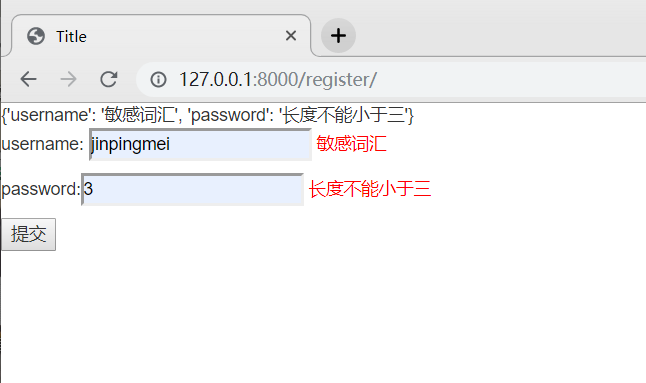
二、form组件的使用
导入from django import forms
2.1 定义一个MyRegForm类
class MyRegForm(forms.Form):
username = forms.CharField(min_length=3, max_length=5)
password = forms.CharField(min_length=3, max_length=6)
email = forms.EmailField()
2.2 校验数据
#校验数据导入模块
from app01 import views
# 1. 给自定义的类传一个字典
obj = views.MyRegForm({'username':'randy',"password":"123", 'email:':'12345'})
# 2.判断数据是否全部合法
obj.is_valid()
Out[8]: False
# 3.查看符合数据的字段
obj.cleaned_data
Out[9]: {'username': 'randy', 'password': '123'}
# 4.查看不符合条件的数据,以及显示符合数据的原因
obj.errors
Out[10]: {'email': ['This field is required.']}

# 5.校验数据的时候 默认情况下类里面所有的字段都必须传值
obj = views.MyRegForm({'username':'randy',"password":"12"})
obj.is_valid()
Out[12]: False
obj.errors
Out[13]:
{'password': ['Ensure this value has at least 3 characters (it has 2).'],
'email': ['This field is required.']}
# 6.默认情况下可以多传 但是绝对不能少传
obj = views.MyRegForm({'username':'randy','password':'123','email':'123456@qq.com','res':'ooo'})
obj.is_valid()
Out[15]: True
2.3 页面渲染三种方式
forms组件只会帮你渲染获取用户输入(输入,选择,下拉框...)的标签 提交按钮需要自己手动写
# urls.py
from app01 import views
urlpatterns = [
url(r'^formss/', views.formss),
]
# views.py
def formss(request):
# 1. 生成一个空对象
form_obj = MyRegForm() # 两个对象名要相同
if request.method == 'POST':
#2. 获取用户提交的数据
print(request.POST)
# 3.记住与form组件帮助我们校验
form_obj = MyRegForm(request.POST)
# 4 判断用户输入的数据是否符合校验规则
if form_obj.is_valid():
return HttpResponse("上传的数据没有问题")
else:
return HttpResponse("上传的数据存在问题")
return render(request, '04formss表单校验.html', locals())
页面渲染方式一
<form action="" method="post" novalidate>
<h2>页面渲染方式一</h2>
{{ form_obj.as_p }} <!--as_p指定包裹的标签,采用p标签包裹-->
{#{{ form_obj.as_ul }}#}
<input type="submit" value="验证">
</form>

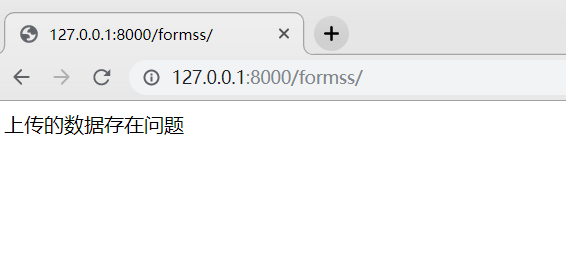
第一种渲染前端页面的方式:封装程度太高了 标签样式及参数不方便调整 可扩展性差(不推荐使用)
<form action="" method="post" novalidate>
<h2>页面渲染方式二</h2>
<p>
{{ form_obj.username.label }}{{ form_obj.username }}
</p>
<p>
{{ form_obj.password.label }}{{ form_obj.password }}
</p>
<p>
{{ form_obj.email.label }} {{ form_obj.email }}
</p>
<input type="submit" value="验证">
</form>

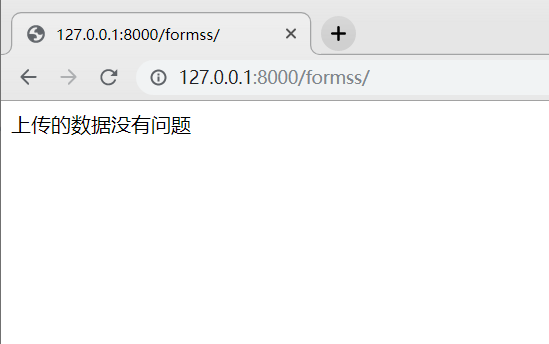
第二种渲染页面的方式:扩展性较高 不足之处在于 需要你手写的代码量比较多(不推荐使用)
<form action="" method="post" novalidate>
<h2>页面渲染方式三</h2>
{% for res in form_obj %}
<p>
{{ res.label }}:{{ res }}
<span style="color:red">{{ res.errors.0 }}</span>
</p>
{% endfor %}
<input type="submit" value="验证">
</form>
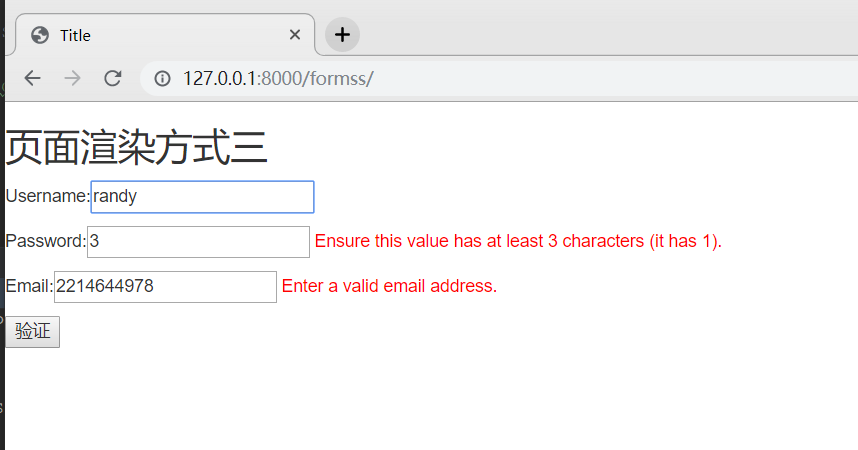
第三种渲染前端页面的方式:代码量和扩展性都很高(推荐使用),展示错误信息 用对象点errors.0
三、form其他验证参数
from django import forms
from django.forms import widgets # 当你forms点不出来的时候 你可以手动导入一下
from django.core.validators import RegexValidator
class MyRegForm(forms.Form):
username = forms.CharField(min_length=3, max_length=5,
error_messages={
'min_length': '用户最短三位',
'max_length': '用户最长八位',
'required': '用户名不能为空',
}, initial='设置初始值', required=False,
widget=forms.widgets.TextInput(attrs={'class': 'form-control other'}))
password = forms.CharField(min_length=3, max_length=6,
error_messages={
'min_length': '密码最短三位',
'max_length': '密码最长八位',
'required': '密码不能为空'
})
confirm_password = forms.CharField(min_length=3, max_length=8, label='确认密码',
error_messages={
'min_length': '确认密码最短三位',
'max_length': '确认密码最长八位',
'required': '确认密码不能为空'
})
email = forms.EmailField(label='邮箱',
error_messages={
'required': '邮箱不能为空',
'invalid': '邮箱格式不正确'
}, required=False)
phone = forms.CharField(label='手机号',validators=[RegexValidator(r'^[0-9]+$', '请输入数字'), RegexValidator(r'^159[0-9]+$', '数字必须以159开头')])
参数说明:
- min_length: 数据的最小长度
- max_length:数据的最大长度
- error_messages: 对应的报错信息,
- required: 不能为空
- widget:给标签添加样式,添加多个可以通过空格实现
- validators: 支持正则表达式
四、钩子函数
forms提供的标签校验,还满足不了你,可以使用钩子函数添加额外的验证
4.1 局部钩子函数
class MyRegForm(forms.Form):
username = forms.CharField(min_length=3, max_length=10)
password = forms.CharField(min_length=3, max_length=6)
confirm_password = forms.CharField(min_length=3, max_length=8, label='确认密码')
email = forms.EmailField(label='邮箱')
# 当需要对某一个字段数据进行额外的数据校验,可以使用钩子函数
# 针对单个字段,使用局部钩子
def clean_username(self):
# 获取标签
username = self.cleaned_data.get("username")
if 'jinpingmei' in username:
# 给username字段下面提示错误信息
# raise ValidationError("输入敏感词汇)
self.add_error('username', '输入敏感词汇')
return username
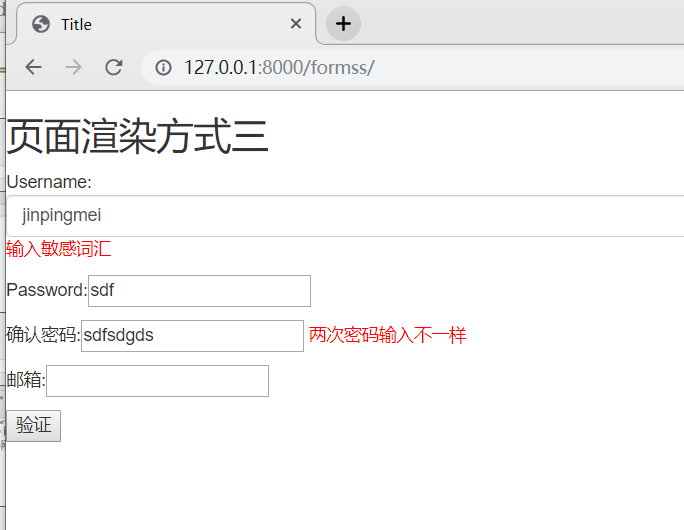
4.2 全局钩子函数
class MyRegForm(forms.Form):
username = forms.CharField(min_length=3, max_length=10)
password = forms.CharField(min_length=3, max_length=6)
confirm_password = forms.CharField(min_length=3, max_length=8, label='确认密码')
email = forms.EmailField(label='邮箱')
# 针对多个字段的校验使用全局钩子
def clean(self):
username = self.cleaned_data.get('username')
confirm_password = self.cleaned_data.get("confirm_password")
if not confirm_password == username:
self.add_error("confirm_password", "两次密码输入不一样")
return self.cleaned_data
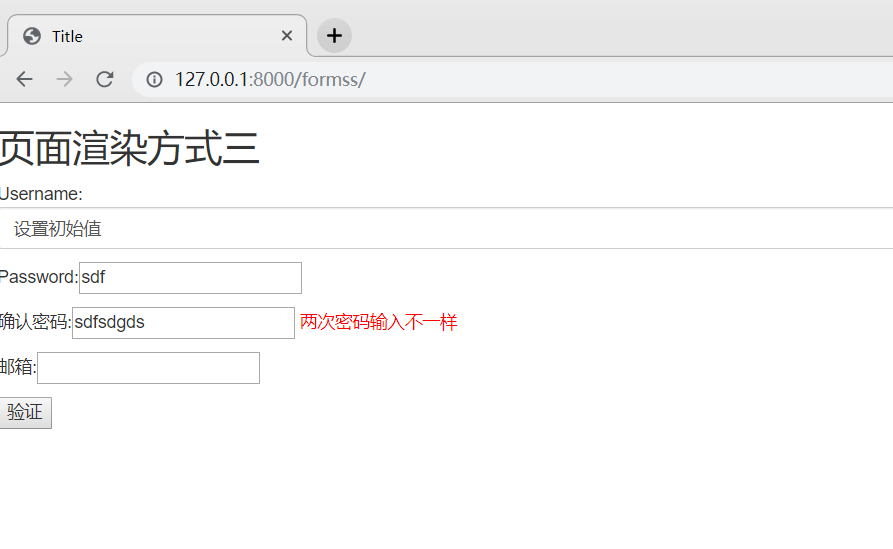
五、其他字段约束条件
常用字段与插件
创建Form类时,主要涉及到 【字段】 和 【插件】,字段用于对用户请求数据的验证,插件用于自动生成HTML;
initial
初始值,input框里面的初始值。
class LoginForm(forms.Form):
username = forms.CharField(
min_length=8,
label="用户名",
initial="张三" # 设置默认值
)
pwd = forms.CharField(min_length=6, label="密码")
error_messages
重写错误信息。
class LoginForm(forms.Form):
username = forms.CharField(
min_length=8,
label="用户名",
initial="张三",
error_messages={
"required": "不能为空",
"invalid": "格式错误",
"min_length": "用户名最短8位"
}
)
pwd = forms.CharField(min_length=6, label="密码")
password
class LoginForm(forms.Form):
...
pwd = forms.CharField(
min_length=6,
label="密码",
widget=forms.widgets.PasswordInput(attrs={'class': 'c1'}, render_value=True)
)
radioSelect
单radio值为字符串
class LoginForm(forms.Form):
username = forms.CharField(
min_length=8,
label="用户名",
initial="张三",
error_messages={
"required": "不能为空",
"invalid": "格式错误",
"min_length": "用户名最短8位"
}
)
pwd = forms.CharField(min_length=6, label="密码")
gender = forms.fields.ChoiceField(
choices=((1, "男"), (2, "女"), (3, "保密")),
label="性别",
initial=3,
widget=forms.widgets.RadioSelect()
)
单选Select
class LoginForm(forms.Form):
...
hobby = forms.ChoiceField(
choices=((1, "篮球"), (2, "足球"), (3, "双色球"), ),
label="爱好",
initial=3,
widget=forms.widgets.Select()
)
多选Select
class LoginForm(forms.Form):
...
hobby = forms.MultipleChoiceField(
choices=((1, "篮球"), (2, "足球"), (3, "双色球"), ),
label="爱好",
initial=[1, 3],
widget=forms.widgets.SelectMultiple()
)
单选checkbox
class LoginForm(forms.Form):
...
keep = forms.ChoiceField(
label="是否记住密码",
initial="checked",
widget=forms.widgets.CheckboxInput()
)
多选checkbox
class LoginForm(forms.Form):
...
hobby = forms.MultipleChoiceField(
choices=((1, "篮球"), (2, "足球"), (3, "双色球"),),
label="爱好",
initial=[1, 3],
widget=forms.widgets.CheckboxSelectMultiple()
)
choice字段注意事项
在使用选择标签时,需要注意choices的选项可以配置从数据库中获取,但是由于是静态字段 获取的值无法实时更新,需要重写构造方法从而实现choice实时更新。
方式一:
from django.forms import Form
from django.forms import widgets
from django.forms import fields
class MyForm(Form):
user = fields.ChoiceField(
# choices=((1, '上海'), (2, '北京'),),
initial=2,
widget=widgets.Select
)
def __init__(self, *args, **kwargs):
super(MyForm,self).__init__(*args, **kwargs)
# self.fields['user'].choices = ((1, '上海'), (2, '北京'),)
# 或
self.fields['user'].choices = models.Classes.objects.all().values_list('id','caption')
方式二:
from django import forms
from django.forms import fields
from django.forms import models as form_model
class FInfo(forms.Form):
authors = form_model.ModelMultipleChoiceField(queryset=models.NNewType.objects.all()) # 多选
# authors = form_model.ModelChoiceField(queryset=models.NNewType.objects.all()) # 单选
Django Form所有内置字段
Field
required=True, 是否允许为空
widget=None, HTML插件
label=None, 用于生成Label标签或显示内容
initial=None, 初始值
help_text='', 帮助信息(在标签旁边显示)
error_messages=None, 错误信息 {'required': '不能为空', 'invalid': '格式错误'}
validators=[], 自定义验证规则
localize=False, 是否支持本地化
disabled=False, 是否可以编辑
label_suffix=None Label内容后缀
CharField(Field)
max_length=None, 最大长度
min_length=None, 最小长度
strip=True 是否移除用户输入空白
IntegerField(Field)
max_value=None, 最大值
min_value=None, 最小值
FloatField(IntegerField)
...
DecimalField(IntegerField)
max_value=None, 最大值
min_value=None, 最小值
max_digits=None, 总长度
decimal_places=None, 小数位长度
BaseTemporalField(Field)
input_formats=None 时间格式化
DateField(BaseTemporalField) 格式:2015-09-01
TimeField(BaseTemporalField) 格式:11:12
DateTimeField(BaseTemporalField)格式:2015-09-01 11:12
DurationField(Field) 时间间隔:%d %H:%M:%S.%f
...
RegexField(CharField)
regex, 自定制正则表达式
max_length=None, 最大长度
min_length=None, 最小长度
error_message=None, 忽略,错误信息使用 error_messages={'invalid': '...'}
EmailField(CharField)
...
FileField(Field)
allow_empty_file=False 是否允许空文件
ImageField(FileField)
...
注:需要PIL模块,pip3 install Pillow
以上两个字典使用时,需要注意两点:
- form表单中 enctype="multipart/form-data"
- view函数中 obj = MyForm(request.POST, request.FILES)
URLField(Field)
...
BooleanField(Field)
...
NullBooleanField(BooleanField)
...
ChoiceField(Field)
...
choices=(), 选项,如:choices = ((0,'上海'),(1,'北京'),)
required=True, 是否必填
widget=None, 插件,默认select插件
label=None, Label内容
initial=None, 初始值
help_text='', 帮助提示
ModelChoiceField(ChoiceField)
... django.forms.models.ModelChoiceField
queryset, # 查询数据库中的数据
empty_label="---------", # 默认空显示内容
to_field_name=None, # HTML中value的值对应的字段
limit_choices_to=None # ModelForm中对queryset二次筛选
ModelMultipleChoiceField(ModelChoiceField)
... django.forms.models.ModelMultipleChoiceField
TypedChoiceField(ChoiceField)
coerce = lambda val: val 对选中的值进行一次转换
empty_value= '' 空值的默认值
MultipleChoiceField(ChoiceField)
...
TypedMultipleChoiceField(MultipleChoiceField)
coerce = lambda val: val 对选中的每一个值进行一次转换
empty_value= '' 空值的默认值
ComboField(Field)
fields=() 使用多个验证,如下:即验证最大长度20,又验证邮箱格式
fields.ComboField(fields=[fields.CharField(max_length=20), fields.EmailField(),])
MultiValueField(Field)
PS: 抽象类,子类中可以实现聚合多个字典去匹配一个值,要配合MultiWidget使用
SplitDateTimeField(MultiValueField)
input_date_formats=None, 格式列表:['%Y--%m--%d', '%m%d/%Y', '%m/%d/%y']
input_time_formats=None 格式列表:['%H:%M:%S', '%H:%M:%S.%f', '%H:%M']
FilePathField(ChoiceField) 文件选项,目录下文件显示在页面中
path, 文件夹路径
match=None, 正则匹配
recursive=False, 递归下面的文件夹
allow_files=True, 允许文件
allow_folders=False, 允许文件夹
required=True,
widget=None,
label=None,
initial=None,
help_text=''
GenericIPAddressField
protocol='both', both,ipv4,ipv6支持的IP格式
unpack_ipv4=False 解析ipv4地址,如果是::ffff:192.0.2.1时候,可解析为192.0.2.1, PS:protocol必须为both才能启用
SlugField(CharField) 数字,字母,下划线,减号(连字符)
...
UUIDField(CharField) uuid类型
字段校验
RegexValidator验证器
from django.forms import Form
from django.forms import widgets
from django.forms import fields
from django.core.validators import RegexValidator
class MyForm(Form):
user = fields.CharField(
validators=[RegexValidator(r'^[0-9]+$', '请输入数字'), RegexValidator(r'^159[0-9]+$', '数字必须以159开头')],
)
自定义验证函数
import re
from django.forms import Form
from django.forms import widgets
from django.forms import fields
from django.core.exceptions import ValidationError
# 自定义验证规则
def mobile_validate(value):
mobile_re = re.compile(r'^(13[0-9]|15[012356789]|17[678]|18[0-9]|14[57])[0-9]{8}$')
if not mobile_re.match(value):
raise ValidationError('手机号码格式错误')
class PublishForm(Form):
title = fields.CharField(max_length=20,
min_length=5,
error_messages={'required': '标题不能为空',
'min_length': '标题最少为5个字符',
'max_length': '标题最多为20个字符'},
widget=widgets.TextInput(attrs={'class': "form-control",
'placeholder': '标题5-20个字符'}))
# 使用自定义验证规则
phone = fields.CharField(validators=[mobile_validate, ],
error_messages={'required': '手机不能为空'},
widget=widgets.TextInput(attrs={'class': "form-control",
'placeholder': u'手机号码'}))
email = fields.EmailField(required=False,
error_messages={'required': u'邮箱不能为空','invalid': u'邮箱格式错误'},
widget=widgets.TextInput(attrs={'class': "form-control", 'placeholder': u'邮箱'}))
在当下的阶段,必将由程序员来主导,甚至比以往更甚。

